The Laboratory Grinders Market is estimated to be valued at USD 1.3 billion in 2025 and is projected to reach USD 2.7 billion by 2035, registering a compound annual growth rate (CAGR) of 7.5% over the forecast period.
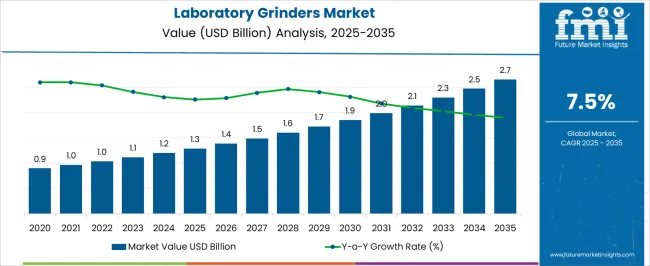
| Metric | Value |
|---|---|
| Laboratory Grinders Market Estimated Value in (2025 E) | USD 1.3 billion |
| Laboratory Grinders Market Forecast Value in (2035 F) | USD 2.7 billion |
| Forecast CAGR (2025 to 2035) | 7.5% |
The Laboratory Grinders market is experiencing steady growth as research and industrial laboratories increasingly prioritize precision, efficiency, and reproducibility in sample preparation. The current market expansion is being influenced by rising demand in pharmaceutical development, food processing, chemical research, and material sciences. Laboratories are seeking grinders that combine operational reliability with adaptable configurations to accommodate varied sample types and volumes.
The transition toward automated workflows and integration with digital laboratory management systems has further strengthened market demand. Future growth is expected to be propelled by the increasing adoption of high-throughput laboratories, the need for consistent particle size reduction, and the emphasis on process standardization. Technological advancements in motor control, wear-resistant materials, and safety mechanisms are enabling laboratory grinders to meet stringent regulatory and operational requirements.
Additionally, the growing investment in research infrastructure across emerging and developed economies supports market expansion As laboratories continue to optimize sample preparation for analytical accuracy and operational efficiency, the Laboratory Grinders market is positioned to experience sustainable growth in both academic and commercial research environments.
The laboratory grinders market is segmented by type, operation type, working application, end use, and geographic regions. By type, laboratory grinders market is divided into Stationary and Hand-Held Or Portable. In terms of operation type, laboratory grinders market is classified into Automated and Manual. Based on working application, laboratory grinders market is segmented into Dry Grinding and Wet Grinding. By end use, laboratory grinders market is segmented into Pharmaceutical Industry, Food & Beverages Industry, Mining Industry, Chemical Industry, Metals & Minerals Industry, Glass & Ceramic Industry, and Others. Regionally, the laboratory grinders industry is classified into North America, Latin America, Western Europe, Eastern Europe, Balkan & Baltic Countries, Russia & Belarus, Central Asia, East Asia, South Asia & Pacific, and the Middle East & Africa.
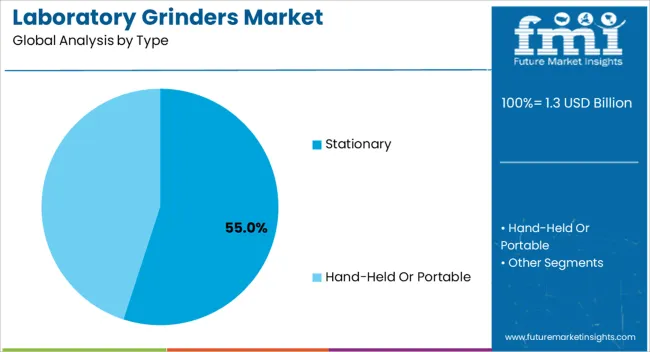
The Stationary type is projected to hold 55.00% of the Laboratory Grinders market revenue share in 2025, making it the leading segment. This dominance is being attributed to the stability, precision, and durability provided by fixed installations, which are essential for repeatable results in laboratory workflows. Stationary grinders are preferred in settings requiring continuous operation and consistent sample handling, as they can accommodate higher workloads without compromising accuracy.
The growth of this segment has been reinforced by the demand for controlled grinding processes that minimize cross-contamination and ensure uniform particle size distribution. As laboratories increasingly adopt standardized protocols and high-volume testing, stationary grinders offer reliable performance and lower operational errors compared to portable alternatives.
Furthermore, the ability to integrate these systems with automated sample handling or processing lines has enhanced their appeal The combination of robustness, operational efficiency, and adaptability to diverse sample types has solidified the Stationary type as the dominant contributor to market revenue.
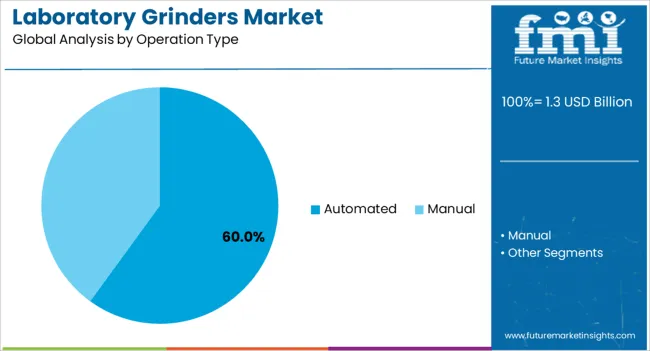
The Automated operation type is expected to account for 60.00% of the Laboratory Grinders market revenue in 2025, highlighting its position as the leading operational category. This prominence is being driven by the rising emphasis on laboratory automation, process standardization, and reduction of human intervention in sample preparation. Automated grinders allow precise control over grinding speed, duration, and pressure, ensuring reproducibility and minimizing operator-dependent variability.
The adoption of automated systems has been accelerated by growing demand in pharmaceutical and chemical research, where high-throughput sample preparation is required. Additionally, automated grinders reduce the risk of contamination and improve laboratory safety, which has further supported their widespread acceptance.
As laboratories continue to invest in digitized and interconnected research environments, automated grinders offer scalable and efficient solutions that align with modern laboratory workflows The operational efficiency, enhanced control, and compatibility with broader laboratory automation systems have reinforced the Automated segment as the primary growth driver in the market.
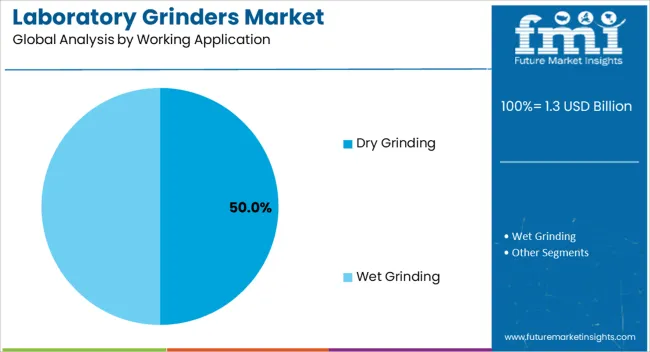
The Dry Grinding working application segment is projected to hold 50.00% of the Laboratory Grinders market revenue share in 2025, establishing it as the largest application type. This leadership is being attributed to the growing demand for powder and particulate analysis across chemical, pharmaceutical, and material research. Dry grinding is particularly valued for its efficiency in producing uniform particle sizes without introducing moisture, which is critical for precise analytical testing.
The segment has benefited from laboratory requirements for reproducible results, low contamination risk, and rapid processing times. The ability to handle a wide variety of sample materials and maintain consistency in output has reinforced the adoption of dry grinding systems.
Additionally, the scalability of dry grinding equipment to support high-throughput laboratories has contributed to its growth As research and industrial laboratories continue to emphasize accuracy, speed, and process optimization, the Dry Grinding application is expected to remain the leading working type, supporting overall market expansion.
The laboratory grinders market is segmented by type, operation type, working application, end use, and geographic regions. By type, laboratory grinders market is divided into Stationary and Hand-Held Or Portable. In terms of operation type, laboratory grinders market is classified into Automated and Manual. Based on working application, laboratory grinders market is segmented into Dry Grinding and Wet Grinding. By end use, laboratory grinders market is segmented into Pharmaceutical Industry, Food & Beverages Industry, Mining Industry, Chemical Industry, Metals & Minerals Industry, Glass & Ceramic Industry, and Others. Regionally, the laboratory grinders industry is classified into North America, Latin America, Western Europe, Eastern Europe, Balkan & Baltic Countries, Russia & Belarus, Central Asia, East Asia, South Asia & Pacific, and the Middle East & Africa.
The Stationary type is projected to hold 55.00% of the Laboratory Grinders market revenue share in 2025, making it the leading segment. This dominance is being attributed to the stability, precision, and durability provided by fixed installations, which are essential for repeatable results in laboratory workflows. Stationary grinders are preferred in settings requiring continuous operation and consistent sample handling, as they can accommodate higher workloads without compromising accuracy.
The growth of this segment has been reinforced by the demand for controlled grinding processes that minimize cross-contamination and ensure uniform particle size distribution. As laboratories increasingly adopt standardized protocols and high-volume testing, stationary grinders offer reliable performance and lower operational errors compared to portable alternatives.
Furthermore, the ability to integrate these systems with automated sample handling or processing lines has enhanced their appeal The combination of robustness, operational efficiency, and adaptability to diverse sample types has solidified the Stationary type as the dominant contributor to market revenue.
The Automated operation type is expected to account for 60.00% of the Laboratory Grinders market revenue in 2025, highlighting its position as the leading operational category. This prominence is being driven by the rising emphasis on laboratory automation, process standardization, and reduction of human intervention in sample preparation. Automated grinders allow precise control over grinding speed, duration, and pressure, ensuring reproducibility and minimizing operator-dependent variability.
The adoption of automated systems has been accelerated by growing demand in pharmaceutical and chemical research, where high-throughput sample preparation is required. Additionally, automated grinders reduce the risk of contamination and improve laboratory safety, which has further supported their widespread acceptance.
As laboratories continue to invest in digitized and interconnected research environments, automated grinders offer scalable and efficient solutions that align with modern laboratory workflows The operational efficiency, enhanced control, and compatibility with broader laboratory automation systems have reinforced the Automated segment as the primary growth driver in the market.
The Dry Grinding working application segment is projected to hold 50.00% of the Laboratory Grinders market revenue share in 2025, establishing it as the largest application type. This leadership is being attributed to the growing demand for powder and particulate analysis across chemical, pharmaceutical, and material research. Dry grinding is particularly valued for its efficiency in producing uniform particle sizes without introducing moisture, which is critical for precise analytical testing.
The segment has benefited from laboratory requirements for reproducible results, low contamination risk, and rapid processing times. The ability to handle a wide variety of sample materials and maintain consistency in output has reinforced the adoption of dry grinding systems.
Additionally, the scalability of dry grinding equipment to support high-throughput laboratories has contributed to its growth As research and industrial laboratories continue to emphasize accuracy, speed, and process optimization, the Dry Grinding application is expected to remain the leading working type, supporting overall market expansion.
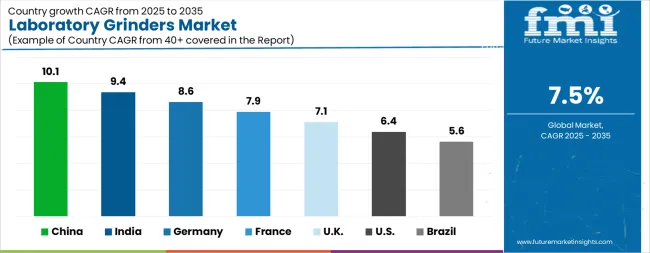
| Country | CAGR |
|---|---|
| China | 10.1% |
| India | 9.4% |
| Germany | 8.6% |
| France | 7.9% |
| UK | 7.1% |
| USA | 6.4% |
| Brazil | 5.6% |
The Laboratory Grinders Market is expected to register a CAGR of 7.5% during the forecast period, exhibiting varied country level momentum. China leads with the highest CAGR of 10.1%, followed by India at 9.4%. Developed markets such as Germany, France, and the UK continue to expand steadily, while the USA is likely to grow at consistent rates. Brazil posts the lowest CAGR at 5.6%, yet still underscores a broadly positive trajectory for the global Laboratory Grinders Market. In 2024, Germany held a dominant revenue in the Western Europe market and is expected to grow with a CAGR of 8.6%. The USA Laboratory Grinders Market is estimated to be valued at USD 466.5 million in 2025 and is anticipated to reach a valuation of USD 865.4 million by 2035. Sales are projected to rise at a CAGR of 6.4% over the forecast period between 2025 and 2035. While Japan and South Korea markets are estimated to be valued at USD 59.2 million and USD 34.7 million respectively in 2025.
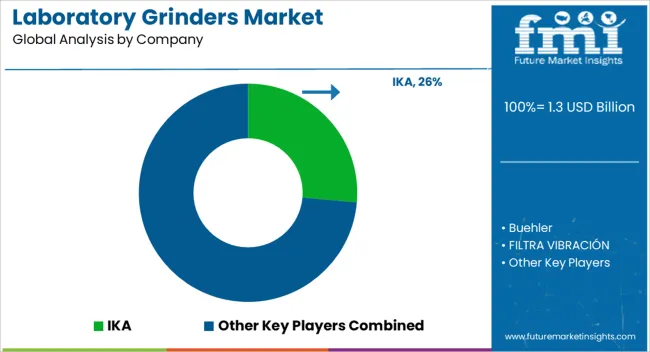
| Item | Value |
|---|---|
| Quantitative Units | USD 1.3 Billion |
| Type | Stationary and Hand-Held Or Portable |
| Operation Type | Automated and Manual |
| Working Application | Dry Grinding and Wet Grinding |
| End Use | Pharmaceutical Industry, Food & Beverages Industry, Mining Industry, Chemical Industry, Metals & Minerals Industry, Glass & Ceramic Industry, and Others |
| Regions Covered | North America, Europe, Asia-Pacific, Latin America, Middle East & Africa |
| Country Covered | United States, Canada, Germany, France, United Kingdom, China, Japan, India, Brazil, South Africa |
| Key Companies Profiled | IKA, Buehler, FILTRA VIBRACIÓN, FRITSCH Holding, Levicron, Sigdo Koppers, Spectris, NETZSCH Group, Retsch, and Union Process |
The global laboratory grinders market is estimated to be valued at USD 1.3 billion in 2025.
The market size for the laboratory grinders market is projected to reach USD 2.7 billion by 2035.
The laboratory grinders market is expected to grow at a 7.5% CAGR between 2025 and 2035.
The key product types in laboratory grinders market are stationary and hand-held or portable.
In terms of operation type, automated segment to command 60.0% share in the laboratory grinders market in 2025.






Our Research Products

The "Full Research Suite" delivers actionable market intel, deep dives on markets or technologies, so clients act faster, cut risk, and unlock growth.

The Leaderboard benchmarks and ranks top vendors, classifying them as Established Leaders, Leading Challengers, or Disruptors & Challengers.

Locates where complements amplify value and substitutes erode it, forecasting net impact by horizon

We deliver granular, decision-grade intel: market sizing, 5-year forecasts, pricing, adoption, usage, revenue, and operational KPIs—plus competitor tracking, regulation, and value chains—across 60 countries broadly.

Spot the shifts before they hit your P&L. We track inflection points, adoption curves, pricing moves, and ecosystem plays to show where demand is heading, why it is changing, and what to do next across high-growth markets and disruptive tech

Real-time reads of user behavior. We track shifting priorities, perceptions of today’s and next-gen services, and provider experience, then pace how fast tech moves from trial to adoption, blending buyer, consumer, and channel inputs with social signals (#WhySwitch, #UX).

Partner with our analyst team to build a custom report designed around your business priorities. From analysing market trends to assessing competitors or crafting bespoke datasets, we tailor insights to your needs.
Supplier Intelligence
Discovery & Profiling
Capacity & Footprint
Performance & Risk
Compliance & Governance
Commercial Readiness
Who Supplies Whom
Scorecards & Shortlists
Playbooks & Docs
Category Intelligence
Definition & Scope
Demand & Use Cases
Cost Drivers
Market Structure
Supply Chain Map
Trade & Policy
Operating Norms
Deliverables
Buyer Intelligence
Account Basics
Spend & Scope
Procurement Model
Vendor Requirements
Terms & Policies
Entry Strategy
Pain Points & Triggers
Outputs
Pricing Analysis
Benchmarks
Trends
Should-Cost
Indexation
Landed Cost
Commercial Terms
Deliverables
Brand Analysis
Positioning & Value Prop
Share & Presence
Customer Evidence
Go-to-Market
Digital & Reputation
Compliance & Trust
KPIs & Gaps
Outputs
Full Research Suite comprises of:
Market outlook & trends analysis
Interviews & case studies
Strategic recommendations
Vendor profiles & capabilities analysis
5-year forecasts
8 regions and 60+ country-level data splits
Market segment data splits
12 months of continuous data updates
DELIVERED AS:
PDF EXCEL ONLINE
Laboratory Precision Oven Market Size and Share Forecast Outlook 2025 to 2035
Laboratory Information System Market Forecast and Outlook 2025 to 2035
Video Extensometer Market Size and Share Forecast Outlook 2025 to 2035
Fluorescence Spectrophotometer Market Size and Share Forecast Outlook 2025 to 2035
Laboratory Centrifuge & Accessories Market Size and Share Forecast Outlook 2025 to 2035
Laboratory Shakers Market Size and Share Forecast Outlook 2025 to 2035
Automated Biochemical Analyzer Market Size and Share Forecast Outlook 2025 to 2035
Vapor Pressure Analyzer Market Size and Share Forecast Outlook 2025 to 2035
Ultrapycnometer Market Size and Share Forecast Outlook 2025 to 2035
Laboratory Washers Market Size and Share Forecast Outlook 2025 to 2035
Laboratory Rockers and Shakers Market Size and Share Forecast Outlook 2025 to 2035
Laboratory Filtration Devices Market Size and Share Forecast Outlook 2025 to 2035
Global PP Closure Market Size and Share Forecast Outlook 2025 to 2035
Global Positioning Systems Market Size and Share Forecast Outlook 2025 to 2035
Laboratory and Medical Scale Ozone Generator Market Size and Share Forecast Outlook 2025 to 2035
Laboratory Furnaces Market Analysis - Size, Share, and Forecast 2025 to 2035
Global Glycidol Market Size and Share Forecast Outlook 2025 to 2035
Global Tert-Amylbenzene Market Size and Share Forecast Outlook 2025 to 2035
Global Sodium Hypochlorite Market Size and Share Forecast Outlook 2025 to 2035
Laboratory Supplies Market Size and Share Forecast Outlook 2025 to 2035

Thank you!
You will receive an email from our Business Development Manager. Please be sure to check your SPAM/JUNK folder too.
Chat With
MaRIA